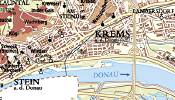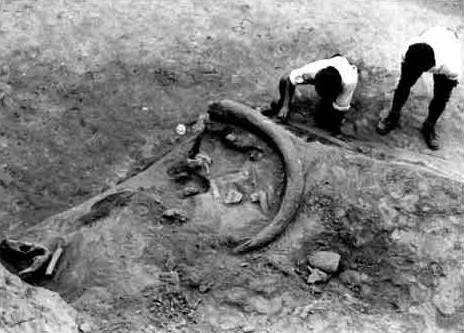Back to Don's Maps
Click on the photos to see an enlarged version
The Mammoths of Krems

Krems on the Danube.
Photo:
http://www.stadt-krems.at/weingut/englisch/vineyards/images/riedenkarte.jpg
 Wachtberg is an area on the outskirts of the major city of Krems on the Danube. The Krems-Wachtberg site is situated on an exposed south-easterly slope, at a height of 260 m a.s.l., within a cluster of Aurignacian and Gravettian sites. The topography is characterised by a hilly area with upland ridges with a base altitude of c. 500 m a.s.l. and peaks at c. 1000 m, and valley floors at c. 200-190 m a.s.l.
Wachtberg is an area on the outskirts of the major city of Krems on the Danube. The Krems-Wachtberg site is situated on an exposed south-easterly slope, at a height of 260 m a.s.l., within a cluster of Aurignacian and Gravettian sites. The topography is characterised by a hilly area with upland ridges with a base altitude of c. 500 m a.s.l. and peaks at c. 1000 m, and valley floors at c. 200-190 m a.s.l.
Photo adapted from: http://wccm.tuwien.ac.at/SocProgr/AccompPers/accomppers.html
Text: The World of Elephants - International Congress, Rome 2001
The Krems-Wachtberg camp-site: mammoth carcass utilization along the Danube 27,000 years ago
F.A. Fladerer, Institute of Paleontology, University of Vienna, Vienna, Austria
 The Krems-Wachtberg site during the excavation in 1930, with the jaw of a mammoth yearling (1.5-2 AEY) with removed premolars (MK 1017) to the left, in front of it a fragment of a left fibula from a sub/adult mammoth with spiral fractures and transverse stepped breaks. To the left and to the right of the tusk (MK 1029) two longitudinal trenches filled with ashy sediments were observed (not seen on the photograph). The rounded larger objects besides the tusk are stones.
The Krems-Wachtberg site during the excavation in 1930, with the jaw of a mammoth yearling (1.5-2 AEY) with removed premolars (MK 1017) to the left, in front of it a fragment of a left fibula from a sub/adult mammoth with spiral fractures and transverse stepped breaks. To the left and to the right of the tusk (MK 1029) two longitudinal trenches filled with ashy sediments were observed (not seen on the photograph). The rounded larger objects besides the tusk are stones.
Photo: Natural History Museum of Vienna, Prehistoric Department via http://www.nmr.nl/deins911.html
In summer 1930 the chance discovery of bones within the loess sediments was followed by a short rescue excavation. The most striking feature within the small site of c.15 square meters were two ditches c. 30 cm in depths filled with ashy sediments (Einw�gerer 2000). The archaeological inventory comprises the oldest, and up till now the only two zoomorphic burnt clay figurines from Austria. The stone artefact assemblage yields c. 2300 finds including 70 tools and over 500 bladelets. Their morphology shows strong affinities to lithics from the Moravian sites of Doln� Vestonice and Pavlov, which are located approximately 100 km away. Charcoal was determined as dwarf Pinus sp. and Abies sp (Cichocki 2000). AMS-dates (27,7�27,1 ka BP), the presence of clay figurines, and the stone tool analysis closely resembles assemblages assigned to the �Pavlovian� culture (for example Kl�ma 1965, Svoboda 1996). 2. MATERIAL The bone sample comprises c. 340 elements and fragments. The archeological documentation did not include a complete inventory of all recoverable bones (Fladerer 2001, in press). The bone surfaces are corroded and destroyed by root etching, and only the deepest parts of cut marks made by humans are preserved (Fig. 4). 3. MAMMOTH BODY REPRESENTATION Proboscidean remains dominate the total bone count (NISP 141, 53% of total NISP) as well as species representation. The skeletal representation shows that elements of the heads, including isolated teeth, represent up to 25% of the carcass remains. An analysis of cranial fragments shows that the age structure predominantly comprises four calves and subadults
Fladerer, F.A. (135-158)
A calf-dominated mammoth age profile from the 27 kyBP stadial Krems-Wachtberg site in the middle Danube valleyFladerer, F.A., 2003 - A calf-dominated mammoth age profile from the 27 kyBP stadial Krems-Wachtberg site in the middle Danube valley - in: Reumer, J.W.F., De Vos, J. & Mol, D. (eds.) - Advances in Mammoth Research (Proceedings of the Second International Mammoth Conference, Rotterdam, May 16-20 1999) - DEINSEA 9: 135-158 [ISSN 0923-9308] Published 24 May 2003
A short rescue-excavation in 1930 at a c.15 m2 encampment area recovered remains from at least eight individual mammoths ( Mammuthus primigenius ), six wolves ( Canis lupus ), four red foxes ( Vulpes vulpes ), one arctic fox (Alopex lagopus ), three wolverines ( Gulo gulo) , and single remains from reindeer ( Rangifer tarandus ), red deer ( Cervus elaphus ), ibex ( Capra ibe x), and musk ox ( Ovibos moschatus ). The body part representation and the bone modification patterns of the species are studied, and the death age profile of the mammoth bone sample is figured. The archeological documentation of the site, the preservation state of the bones, and the evidence of delicate bone fragments support a geologically short-time generated origin of the sample with only light disturbance by carnivores.
The remains of at least four calves of suckling age, as well as two subadults, and two adults, at least one bull, may be caused by the exploitation of a mammoth family group. Within the body parts of the juveniles, heads including isolated milk teeth are overrepresented. The osteological patterns of the proboscidean finds indicate the utilization of head, back, and foot parts, as well as long bone and rib internals. Cortical bone fragments were used for works and tools. By ethological analogy the death age profile pleads for a proliferating mammoth population. The second main property of the sample is the extraordinary high carnivore representation, which is over 50 % of the minimal number of individuals, and the evidence of their butchering.
Under three models about the procurement strategy, the task independent model, the natural co-occurrence model, and the co-occurrence exploiting model, this last one is favoured: The Pavlovian people confronted family herd-units, using any ambush place within the multiformity of the regional landscape, and selectively brought carcass parts back to the residential camp. The prey spectrum and the multiform landscape reflect a variety of potential forage grounds. This and the postulated healthy mammoth herd structure, suggest high yield environmental conditions, and a stable supply position of the Pavlovian people.
Site occupation, interpreted from the mammoth calf ages, and from the osteological patterning of the medium-sized herbivore and carnivore carcasses, was probably during the winter months. The contextual occurrence of the zoomorphous burnt clay figurines and the animal parts may reflect a non-subsistential set of human behavior.